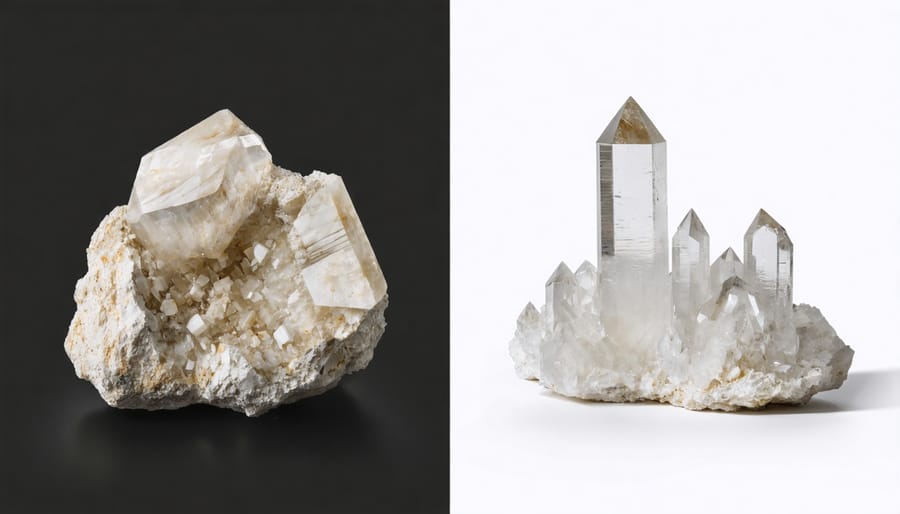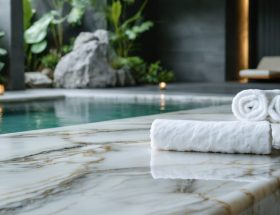Quartz countertops stand as marvels of modern engineering, combining natural beauty with engineered durability. While these surfaces can withstand daily wear and tear with remarkable resilience, their relationship with heat demands careful attention. Unlike natural granite, which forms under extreme temperatures, engineered quartz has specific thermal limitations that every homeowner should understand. At temperatures exceeding 300°F (150°C), quartz surfaces can experience discoloration, warping, or even permanent damage – a crucial consideration for kitchen design and daily use. This threshold becomes particularly relevant in busy kitchens where hot pots, pans, and baking dishes move frequently between cooking surfaces and countertops. Understanding quartz’s heat resistance isn’t just about protection; it’s about preserving your investment and maintaining the stunning aesthetic that makes these surfaces so desirable in contemporary homes.
Understanding Quartz’s Heat Resistance Properties
Natural vs. Engineered Quartz
While both natural stone surfaces and engineered quartz offer distinct advantages, their heat resistance properties differ significantly. Natural quartz, formed over millions of years through geological processes, demonstrates superior heat resistance compared to its engineered counterpart. Pure natural quartz can withstand temperatures up to 1800°F (982°C) before showing signs of damage.
Engineered quartz, while exceptionally durable for everyday use, has lower heat tolerance due to its resin content. These sustainable stone materials typically contain about 90-95% natural quartz combined with polymer resins and pigments. The resin binders begin to weaken at temperatures around 150°F (65°C), making them more susceptible to thermal shock and discoloration when exposed to hot cookware.
However, both materials perform well under normal household conditions when proper heat protection measures are used. The key difference lies in their threshold for direct heat exposure, with natural quartz offering greater thermal stability for high-temperature applications.
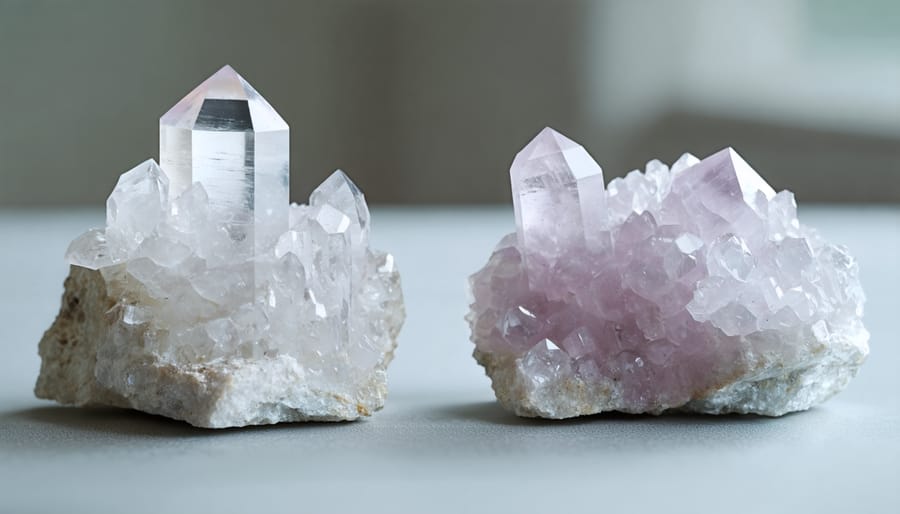
Temperature Thresholds
Quartz surfaces begin to experience noticeable changes when exposed to temperatures above 150°F (65°C). At this point, the resin binding agents that hold the material together start to react. When temperatures reach 300°F (150°C), the surface can suffer permanent damage, including discoloration, cracking, or warping.
The critical threshold occurs around 400°F (204°C), where severe structural damage becomes likely. At these temperatures, the polymer resins can break down completely, compromising the integrity of the material. Direct exposure to heat sources exceeding these temperatures, such as hot pots or pans straight from the stove, can cause immediate thermal shock and potentially irreversible damage.
It’s worth noting that while brief exposure to moderate heat (like a warm plate) won’t typically cause issues, sustained heat exposure even at lower temperatures can accumulate stress in the material over time. The edges and areas around cutouts are particularly vulnerable to heat damage, as these regions may have slightly different stress distributions due to fabrication processes.
To maintain the quality of your quartz surfaces, always use trivets or hot pads when placing hot items on the surface, and avoid direct contact with heating elements or high-temperature appliances.
Real-World Heat Scenarios
Hot Pots and Pans
Placing hot pots and pans directly on quartz countertops can pose significant risks to your surface’s integrity. While quartz is highly durable, direct contact with heated cookware can cause thermal shock, potentially leading to discoloration, cracking, or permanent damage to the resin binding agents within the material.
The resin components in quartz countertops begin to weaken at temperatures around 150°F (65°C), though most cooking vessels can reach temperatures well above 300°F (149°C). When a hot pan makes direct contact with the surface, the sudden temperature change creates localized stress that can compromise the material’s structure.
Common damage patterns include:
– Yellowing or browning of the affected area
– Surface cracks or fissures
– Separation of quartz particles from the resin
– Permanent burn marks or scorching
– Loss of shine in the impacted zone
To protect your quartz countertops, always use trivets, hot pads, or heat-resistant mats under any heated cookware. This simple precaution creates a protective barrier between the hot surface and your countertop, preserving its beauty and structural integrity. For added protection, allow pots and pans to cool before placing them on any surface protectors, as extreme heat can sometimes transfer through these barriers.
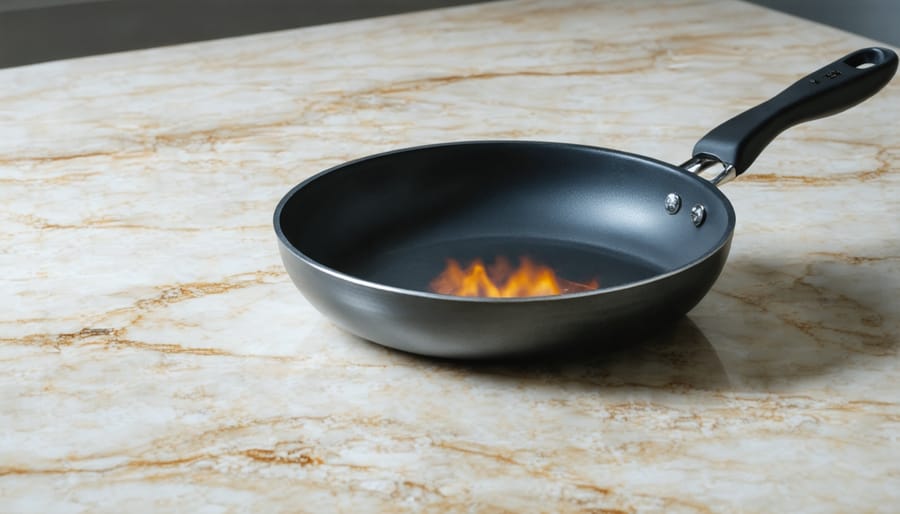
Appliance Heat Transfer
When installing quartz countertops, it’s essential to consider the placement of heat-generating appliances and their potential impact on the surface. While quartz is generally heat-resistant, prolonged exposure to high temperatures from appliances can affect its integrity and appearance.
Common kitchen appliances like coffee makers, slow cookers, and toaster ovens typically operate at temperatures between 150°F to 400°F. While brief contact may not cause immediate damage, consistent heat exposure in these areas can lead to discoloration or thermal shock, particularly if the surface experiences sudden temperature changes.
To protect quartz surfaces near heat-producing appliances:
– Install heat-reflective strips or barriers between the appliance and the countertop
– Use trivets or hot pads under appliances that generate constant heat
– Maintain a minimum 2-inch gap between hot appliances and the quartz surface
– Consider installing dedicated spaces or platforms for frequently used hot appliances
Built-in appliances like cooktops require special attention during installation. Professional installers should follow manufacturer guidelines for proper clearance and insulation. Most manufacturers recommend a minimum clearance of 1/8 inch between the cooktop and the surrounding quartz surface, with heat-reflective tape applied to protect against thermal transfer.
By taking these precautions, you can maintain the beauty and durability of your quartz surfaces while safely accommodating your kitchen appliances.
Protecting Your Quartz Investment
Essential Heat Protection Measures
To protect your quartz surfaces from heat damage, implementing proper protection measures is essential. Always use trivets, hot pads, or heat-resistant mats when placing hot items on quartz countertops. These protective tools should be kept readily accessible in kitchen drawers or mounted on nearby walls for convenience.
Invest in quality silicone pot holders or cork-based trivets, as these materials offer excellent heat resistance without scratching the surface. For frequently used cooking areas, consider installing permanent heat-resistant pads or strips that blend with your countertop design.
When using appliances that generate heat, such as electric skillets, slow cookers, or portable burners, always place them on protective surfaces rather than directly on quartz. Keep a designated cooling rack or heat-safe surface for hot pots and pans fresh from the oven or stovetop.
For additional protection, maintain a safe distance between heat-generating appliances and quartz surfaces. If possible, create dedicated zones for hot items using built-in cutting boards or stainless steel inserts. This practical approach not only protects your quartz but also organizes your kitchen workspace efficiently.
Remember to educate all household members about these protection measures to ensure consistent care and maintenance of your quartz surfaces.
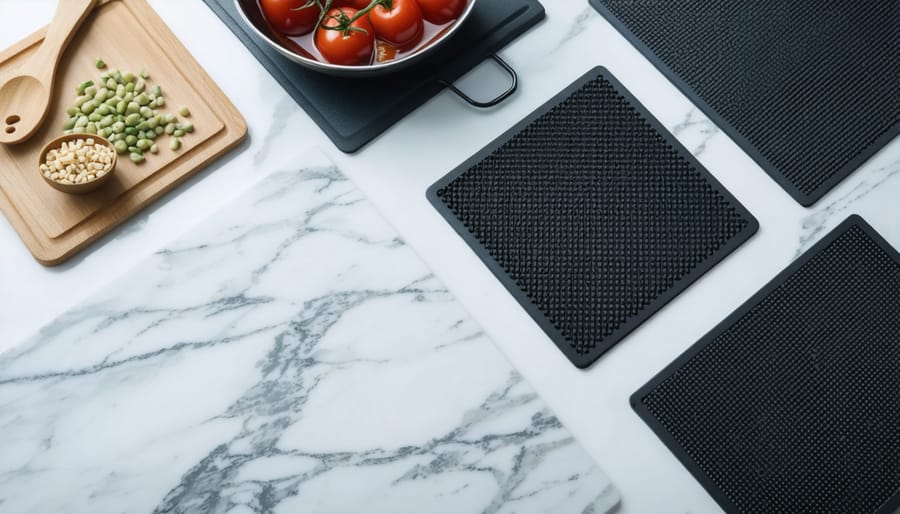
Signs of Heat Damage
Heat damage on quartz surfaces manifests in several distinct ways that homeowners and professionals should watch for. The most common sign is discoloration, which often appears as yellowish or brownish spots where hot items have made direct contact. In severe cases, you might notice crazing – a network of fine cracks on the surface that resembles a spider web pattern.
Physical deformation is another serious indicator of heat damage. The resin binding agents in quartz can soften and warp when exposed to extreme temperatures, potentially leading to permanent surface distortion or separation from the substrate. You may also observe a loss of shine or dull patches in affected areas.
If you notice any of these signs, immediately discontinue placing hot items directly on the surface. While minor discoloration might be addressed through professional restoration services, severe damage often requires complete replacement of the affected section. To prevent future damage, always use trivets and hot pads, and maintain a safe distance between heat sources and your quartz surfaces.
Regular inspection of areas near cooktops and other heat sources can help catch early signs of damage before they become severe. If you’re uncertain about potential damage, consult with a certified stone professional for proper assessment and recommendations.
Quartz countertops offer impressive durability and heat resistance up to 150°C (300°F), making them a reliable choice for kitchen applications. However, it’s crucial to remember that while quartz can withstand moderate heat exposure, direct contact with extremely hot items can potentially damage the surface or weaken the resins binding the material together.
To maintain your quartz surfaces’ integrity and appearance, always use trivets or hot pads under hot cookware, avoid placing hot pans directly on the surface, and keep heating appliances on protective surfaces. Regular cleaning with mild soap and water, prompt attention to spills, and avoiding harsh chemical cleaners will help preserve the material’s heat-resistant properties and overall durability.
For optimal performance and longevity, combine these preventive measures with proper installation by certified professionals. While quartz remains one of the most heat-resistant engineered stone options available, responsible use and regular maintenance will ensure your surfaces remain beautiful and functional for years to come. Remember that different manufacturers may have varying heat resistance specifications, so always consult your specific product guidelines for detailed care instructions.

